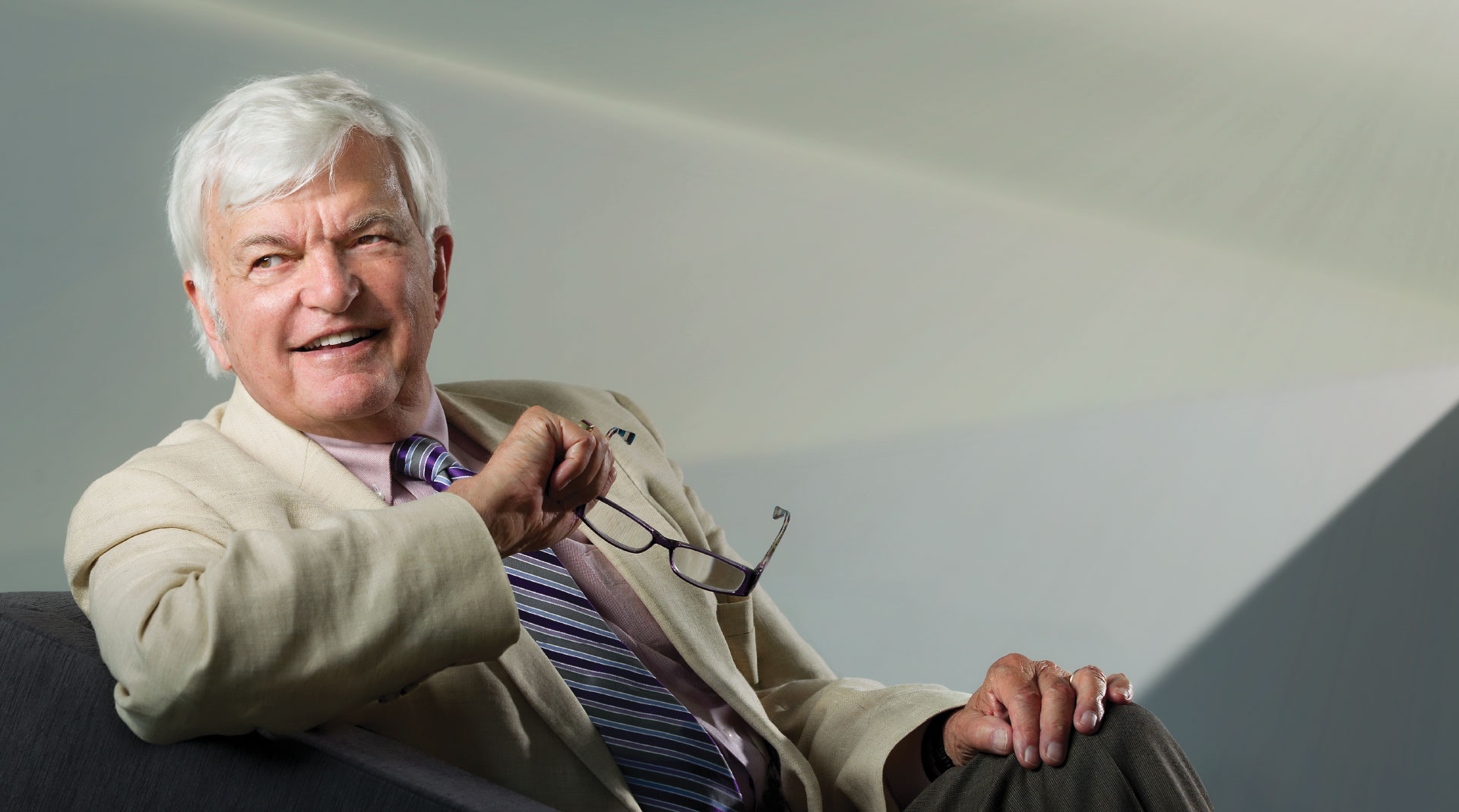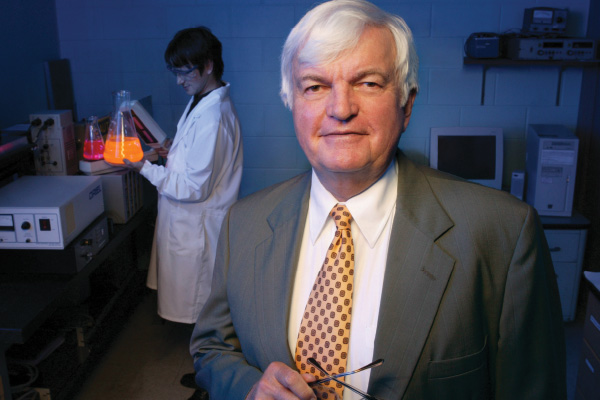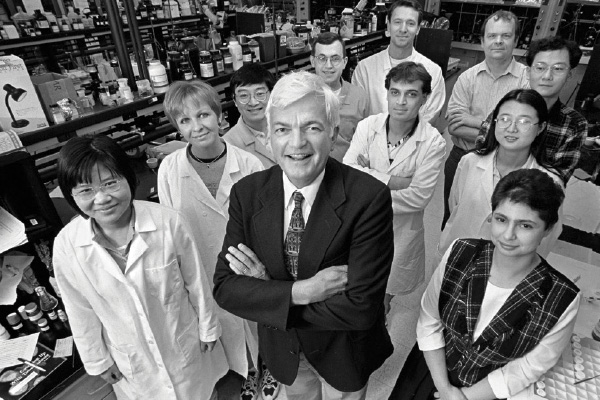
by Bonnie Blankinship

A Force of Nature, a Life of Invention
Douglas Neckers marries photochemical science, commerce
by Bonnie Blankinship
“I’m an inventor — and an entrepreneur,” said Dr. Douglas Neckers, McMaster Distinguished Research Professor Emeritus of Photochemical Sciences. There are many more adjectives that could just as aptly describe him — businessman, leader, public intellectual, change agent and musician — but perhaps “Renaissance man” expresses him best.
From his early days as a promising organic chemist to his current roles as CEO of Spectra Group Limited Inc., and the Henry T. King Fellow at the Robert H. Jackson Center, Neckers has exhibited a prodigious intellect, energy and output.
Although people’s eyes may glaze over at the mention of “photochemical sciences” — a term coined by Neckers — it simply means the interaction of light with matter. Its applications include practical solutions to problems confronted by industry and medicine. When a dentist shines a blue
light on a new filling to quickly harden it, photochemistry is in action. It is an interdisciplinary science comprising chemistry, biology, materials science and physics.
The holder of 65 patents, Neckers, along with his research group, has been responsible for such useful items as the plastic coating on capsules that makes it possible for people to take medicines such as insulin orally, and for quick-drying coatings for engines and algacide-infused paint for the hulls of ships. Photochemistry also has important applications in electronics, photography, printing and manufacturing.
It has also put Bowling Green State University on the map among the global community of scientists.
Along the way, Neckers has received myriad fellowships, awards and honors from the scientific community along with significant funding for students and sophisticated equipment. He has enjoyed the friendship and professional support of other visionaries such as Harold McMaster, the Toledo chemist and inventor who founded the automotive supplier Glasstech and later started First Solar, one of the original alternative energy firms; and Paul Block, publisher of The (Toledo) Blade and chemist who developed synthetic thyroid hormones and a lung treatment for premature infants. Harold and Helen McMaster and Block provided critical contributions to the BGSU program.
A thread that has colored Neckers’ career has been leadership: his belief in the Constitution and the power of strong leaders — both elected and appointed — to inspire the University, the community and the country to new levels of achievement. Equally strong is his belief in the responsibility to “nurture the next generation of scholars and leaders to a level that they can perform to everyone’s benefit. The objective is to leave things better tomorrow than they are today,” he said.
Neckers came to BGSU in 1973 as the 35-year-old chair of the chemistry department, charged with creating a Ph.D. program in chemistry. He did indeed succeed in forming a Ph.D. program, in 1989, although it turned out to be in photochemical sciences and through the Center for Photochemical Sciences, which he founded in 1985.
“I came because I liked the people,” Neckers said. “The facilities at the time were crummy. Overman Hall was not really functional for the developing scientific community and Hayes Hall wasn’t either. It was perhaps professionally stupid, but personally great — so I moved.”
“When the University hired Doug, they were rewarded beyond their fondest dreams in terms of the department and what he accomplished,” said Dr. J. Christopher Dalton, Trustee Professor of chemistry and one of the first people hired by Neckers. “He took it from a department with a master’s program that was focused on producing teachers to one with a Ph.D. program and an Eminent Scholar that places graduates in industry around the country.”
“Most chemistry departments produce graduates who go on to work in academia, but Doug has always had a very practical focus and looks for the applications of the pure science,” said Ellen Dalton, also a chemist, who joined Neckers to develop a science education component for the center before she became the budget officer for the College of Musical Arts.
Having Chris Dalton on board, with his distinguished background and academic contacts, also attracted others in the discipline, and the department’s reputation grew along with Neckers’ own.
Soon he was traveling the world as a consultant, sometimes giving courses in basic photochemical sciences with Chris Dalton at meetings of the Society of Photo-instrumentation Engineers. The contacts made in academia and industry brought in funds and creative energy. “My area of research had been discovered by companies that were rapidly turning liquids to solids — as in coatings for floors, as in your tooth fillings — so I had lots of friends in industry who wanted to know the basics and get up to date,” Neckers said.

A key development for the photochemical sciences program came even before the inception of the Ph.D. degree, when Governor Richard Celeste’s administration issued some selective excellence initiatives in the 1980s. “These were peer-reviewed and competitive grant programs, and in the undergraduate competition we came out number one in the state,” Neckers said.
With this validation, he asked then-Ohio Board of Regents Chancellor Elaine Hairston if BGSU could apply for an Ohio Eminent Scholar, even though it only had a master’s program in chemistry. The application was approved, and in 1988 Neckers recruited Dr. Michael Rodgers, then a senior research scientist at the University of Texas at Austin and expert in photodynamic therapy for cancer, to be the first Ohio Eminent Scholar not only at BGSU but in northwest Ohio.
Central to gaining the Ph.D. program was the creation of the Center for Photochemical Sciences, which functioned as an interdisciplinary unit and set BGSU apart from other chemistry programs. Early funding came from the McMaster family, who in 1985 donated $1 million to BGSU for a McMaster Institute (leaving a check on the piano after a dinner party at former Vice President for University Relations Dwight Burlingame’s home). The income has since supported numerous graduate students as McMaster Fellows and later was also used to support the center — which, as Neckers remembered was at first just “myself, Dalton and a letterhead.”
“We used to invite Harold and Helen McMaster over to meet their new graduate student ‘grandkids.’ They were so pleased,” said Neckers, who by then had been named BGSU’s first Distinguished Research Professor and brought in more than $1.24 million in external funding and equipment grants. The funds also enabled BGSU in 1989 to hire Dr. George Hammond, another nationally prominent photochemist and later winner of the National Medal of Science, as a senior McMaster Fellow.
The center hosted conferences attracting leading scientists and in 1993 began publishing The Spectrum, a journal read by researchers around the globe.
As Rodgers recalls, “Doug showed himself to be a visionary in pushing for the establishment of the center and it was his determined energy that got it off the ground and kept it going and growing. The center became unique in the photosciences field: a collection of scholars all pointed in the same direction. Neckers initiated a Ph.D. program at a time when other state universities in Ohio were closing down their chemistry Ph.D. programs for lack of students. His genius was to establish a niche program that attracted students from all over the world. In addition to all this ‘structural’ activity, Doug established his own very strong research program in polymer photoinitiation. The 20 or so years that I worked alongside Doug were among the most exciting years of my career.”
Today, the Center for Photochemical Sciences, under the direction of Dr. Felix Castellano, continues to be an international hub for breakthroughs in research focusing on interactions of light with matter. With expansion into new areas of study and some of the world’s most sophisticated spectrometers, chromatographs, calorimeters, microscopes and laser systems, BGSU’s scientists continue to build upon Neckers’ original vision.
Despite his commitment to research and business, teaching is central to Neckers’ feelings about the role of academia. “If you’re in my business, if you’re a university professor, you teach. I don’t believe in professors who only do research, or, for that matter, only teach,” he said.
And not only at the upper levels. Neckers has been a strong proponent of teaching science at the undergraduate levels as well. Among his 10 books are textbooks in basic organic chemistry.
He has long been perplexed and dismayed by the decline in strong science and math majors in the United States, and has often taken a public stand on the issue.
“America is in a competition for its economic future,” he said. “Education is the only way to counter this. Universities have to be there to give the kid from whatever economic sector here or anywhere in
the world the chance to live the American dream.”
His doors have always been open to international students, which made Bowling Green the unlikely home of top students from Russia and China long before it was common. “Former University President Paul Olscamp called me up in October 1990, before the fall of the Soviet Union, and said, ‘Neckers, how would you like to go to Russia?’ I said, ‘You’ve got to be kidding me.’”
Olscamp was heading to Moscow to sign an agreement with the D. Mendeleev University of Chemical Technology for a collaborative program, and Neckers agreed to go. The meeting with Natasha Tarasova, director of the Institute of Chemistry and Problems of Sustainable Development at Mendeleev, and others there proved extremely fruitful.
“He was full of ideas,” Tarasova said. “It attracted young people, who later became his Ph.D. students, colleagues and friends. I think that this desire to start something new is typical for Doug, nowadays as well. I think that this exchange helped to promote chemistry worldwide.”

Neckers has seen many beginnings come full circle, particularly where the people are concerned, whether they are international leaders of science and industry or those who have overcome great odds to build a life.
An early BGSU friend and influence was Laszlo Kecskes, who ran the machine shop in the basement of Overman Hall. Shot 17 times when Soviet tanks rolled into Budapest in 1956, he had escaped and come to America. Remembering his old friend Kecskes moved Neckers to tears years later, he said, when, standing with his wife, Suzanne, in front of a memorial to the students killed in the 1956 Budapest uprising, he received an email from a former BGSU doctoral student from Nigeria telling him he had just received his green card to work in the United States.
“I thought of the two people — one shot for wanting freedom and democracy and the other accepted by us because he wanted an education to make a better life. It was an emotional moment.”
Just as Neckers has played a pivotal role in the formation of the center and the many lives affected, so, too, has he had a role at some seminal points in the photochemical sciences field. “There have been some thrills,” he acknowledged.
Following a newspaper story about the new center, Neckers got a call from Chuck Hull, one of America’s premier inventors, asking him to come immediately to 3D Systems in California. Hull and two engineers showed him a “petri dish of blue goop and a penlight. Under the surface there was a little platform; he added a layer of the goop and shined the light on it and it became solid. As he added more layers it took shape — and that was the beginning of what we now call ‘additive modeling.’”
Hull needed some help with the photopolymerization, but Neckers immediately recognized the invention had tremendous potential. Eventually, the laser took the place of the penlight, Neckers said, adding, “They called it stereolithography. One 3D scientist said they would have liked to call it photosynthesis but that was already taken. What they were creating was the rapid prototyping revolution.”
Neckers introduced 3D Systems’ principals to representatives from a Swiss company, who made a major purchase of 3D stock that provided the funds for development. “In May 2011 when 3D was listed on the New York Stock Exchange, that was a great thrill,” he said.
Partnering academia with business, Neckers and his BGSU group put the additive modeling technique to medical use, and were the first in the world to produce models of organs and bones from CT and MRI scans to aid doctors. With additional funding from the state, investors, and the help of McMaster and Norman Nitschke, a startup company, StereoGraphics Limited Partnership, was begun in 1990 to produce medical models.
Now renamed Spectra Group, the company employs almost exclusively graduates of the BGSU doctoral program, including its president, Alex Mejeritski, one of the students Neckers recruited. Spectra’s most recent project is creating simulated blood that can be used to train EMTs and military medics.
By the time he retired from BGSU in 2009, Neckers had become increasingly involved with the Robert H. Jackson Center. His passion for World War II studies arose from his being deeply disturbed that German organic chemists could have contributed so heavily to the atrocities of the Holocaust. His affiliation with the Jackson Center has allowed him to explore the interactions of science and government, while providing opportunities for BGSU students and faculty to conduct research there. The center, in Jamestown, N.Y., is a historical research archive nurturing the legacy of Jackson, the late Supreme Court associate justice and lead U.S. prosecutor at the Nuremburg military trials.
Neckers also loves music. In addition to being a board member of the Toledo Symphony, his passion for Anglican choral music led to his singing in the Canterbury Singers, USA. The group did a cathedral residency in July 2011 in England and will return to sing in December 2012 and January 2013. “Doug is a vital, moving force within this group. He’s brought numerous opportunities to the table for it to perform. We’re more like a family who comes together to sing,” said Tina Bunce, formerly of the College of Musical Arts.
Ellen Dalton offered some insight into how Neckers has managed to maintain a very active research group, teach, pursue grants, network, write textbooks and innumerable research papers and invest a lot of time in his two children. “He doesn’t agonize over details. Once he makes a decision he moves on,” she said. “He’s very results-driven and doesn’t have a lot of patience for delayed gratification.”
As Rodgers said, “Doug’s personality is that of a determined fighter; once he has an idea he will do everything in his power to bring it to fruit.”
Hundreds of former students and colleagues attested to this a few years ago when they sent wishes and attended his 70th birthday party to thank their mentor and supporter.
“Students are what we’re here for. BGSU has a lot to be proud of,” Neckers said.
Updated: 12/02/2017 12:00AM
